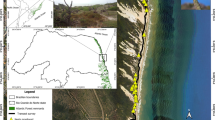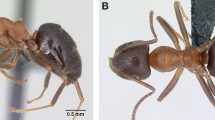Abstract
Dispersing from the natal nest to found new nests is an avenue for gaining direct fitness for workers in some primitively eusocial insects, especially in species with a perennial nesting cycle where males are present throughout the year. Such nest foundation is difficult to study in nature or in small laboratory cages. Hence, we have investigated the dynamics of nest foundation by workers of the primitively eusocial wasp Ropalidia marginata inside closed walk-in cages so that we could locate and observe every event of nest foundation. Starting with nine parent nests we observed the dispersal of female workers that initiated 9 single-foundress and 20 multiple-foundress nests. Wasps congregated outside their parent nests and engaged in dominance–subordinate interactions before initiating multiple foundress nests. The most dominant wasps of such aggregations became queens, and among the others, some joined the new nests as cofoundresses to become workers while the others remained in the parent nests. Solitary foundresses never participated in such off-nest aggregations. Solitary foundresses and future queens of multiple foundress nests engaged in self-feeding behaviour outside their parent nests, a behaviour not performed by wasps that did not initiate new nests. Queens of new nests gained immediate direct fitness. Although the cofoundresses continued to gain only indirect fitness, they are expected to have a higher probability of gaining direct fitness in the future as compared to the corresponding probability in their much larger parent nests. These findings underscore the importance of direct fitness in the evolution of cooperation in primitively eusocial insects.


Similar content being viewed by others
References
Bang A, Gadagkar R (2012) Reproductive queue without overt conflict in the primitively eusocial wasp Ropalidia marginata. Proc Natl Acad Sci U S A 109:14494–14499. https://doi.org/10.1073/pnas.1212698109
Blacher P, Yagound B, Lecoutey E et al (2013) Drifting behaviour as an alternative reproductive strategy for social insect workers. Proc R Soc B-Biol Sci 280:1–7
Bourke AFG (2011) Principles of social evolution. Oxford University Press, Oxford
Brahma A, Mandal S, Gadagkar R (2018a) Emergence of cooperation and division of labor in the primitively eusocial wasp Ropalidia marginata. Proc Natl Acad Sci. https://doi.org/10.1073/pnas.1714006115
Brahma A, Mandal S, Gadagkar R (2018b) Current indirect fitness and future direct fitness are not incompatible. Biol Lett 14:8–11. https://doi.org/10.1098/rsbl.2017.0592
Cant MA, Field J (2001) Helping effort and future fitness in cooperation animal societies. Proc R Soc London Ser B Biol Sci 268:1959–1964. https://doi.org/10.1098/rspb.2001.1754
Chandrashekara K, Gadagkar R (1991) Unmated queens in the primitively eusocial wasp Ropalidia marginata (Lep.) (Hymenoptera: Vespidae). Insectes Soc 38:213–216. https://doi.org/10.1007/BF01240971
Crozier RH, Pamilo P (1996) Evolution of social insect colonies: sex allocation and kin selection. Oxford University Press, Oxford
Dapporto L, Palagi E, Turillazzi S (2005) Sociality outside the nest: helpers in pre-hibernating clusters of Polistes dominulus. Ann Zool Fennici 42:135–139
Dapporto L, Palagi E, Cini A, Turillazzi S (2006) Prehibernating aggregations of Polistes dominulus: an occasion to study early dominance assessment in social insects. Naturwissenschaften 93:321–324. https://doi.org/10.1007/s00114-006-0104-3
Gadagkar R (2001) The social biology of Ropalidia marginata: toward understanding the evolution of eusociality. Harvard University Press, Cambridge
Gadagkar R, Vinutha C, Shanubhogue A, Gore AP (1988) Pre-imaginal biasing of caste in a primitively eusocial insect. Proc R Soc London Ser B Biol Sci 233:175–189. https://doi.org/10.1098/rspb.1988.0017
Gamboa GJ, Dropkin JA (1979) Comaprisons of behaviours in early vs. late foundress associations of the paper wasp, Polistes metricus (Hymenoptera: Vespidae). Can Entomol 111:919–926
Grinsted L, Field J (2017a) Biological markets in cooperative breeders: quantifying outside options. Proc R Soc London Ser B Biol Sci 284. https://doi.org/10.1098/rspb.2017.0904
Grinsted L, Field J (2017b) Market forces influence helping behaviour in cooperatively breeding paper wasps. Nat Commun 8:1–8. https://doi.org/10.1038/ncomms13750
Hamilton WD (1964a) The genetical evolution of social behaviour. I. J Theor Biol 7:1–16. https://doi.org/10.1016/0022-5193(64)90038-4
Hamilton WD (1964b) The genetical evolution of social behaviour. II. J Theor Biol 7:17–52. https://doi.org/10.1016/0022-5193(64)90039-6
Holldobler B, Wilson EO (1990) The Ants. The Belknap Press of Harvard University Press, Cambridge
Ito Y (1993) Behaviour and social evolution of wasps: the communal aggregation hypothesis. Oxford University Press, Oxford
Keeley LL (1985) Physiology and biochemistry of the fat body. In: Kerkut GA, Gilbert LI (eds) Comprehensive insect physiology, biochemistry and pharmacology, vol 3. Pergamon Press, Oxford, pp 211–248
Leadbeater E, Carruthers JM, Green JP, Van Heusden J (2010) Unrelated helpers in a primitively eusocial wasp: is helping tailored towards direct fitness? PLoS ONE 5:1–7. https://doi.org/10.1371/journal.pone.0011997
Leadbeater E, Carruthers JM, Green JP et al (2011) Nest inheritance is the missing source of direct fitness in a primitively eusocial insect. Science 333:874–876. https://doi.org/10.1126/science.1205140
Premnath S, Sinha A, Gadagkar R (1996) Dominance relationship in the establishment of reproductive division of labour in a primitively eusocial wasp (Ropalidia marginata). Behav Ecol Sociobiol 39:125–132
Röseler P-F (1991) Reproductive competition during colony establishment. In: Ross KG, Matthews RW (eds) The social biology of wasps, 1st edn. Cornell University Press, Ithaca, pp 309–335
Ross KG, Matthews RW (1991) The Social biology of wasps. Cornell University Press, Ithaca
RStudio Team (2015) RStudio: integrated development for R. RStudio, Inc. http://www.rstudio.com/. Accessed 20 Dec 2018
Seppä P, Queller DC, Strassmann JE (2012) Why wasp foundresses change nests: relatedness, dominance, and nest quality. PLoS Comput Biol. https://doi.org/10.1371/journal.pone.0045386
Shakarad M, Gadagkar R (1995) Colony Founding in the Primitively Eusocial Wasp, Ropalidia marginata (Hymenoptera, Vespidae). Ecol Entomol 20:273–282
Shakarad M, Gadagkar R (1997) Do social wasps choose nesting strategies based on their brood rearing abilities? Naturwissenschaften 84:79–82
Shukla S, Shilpa MC, Gadagkar R (2013) Virgin wasps develop ovaries on par with mated females, but lay fewer eggs. Insectes Soc 60:345–350. https://doi.org/10.1007/s00040-013-0299-1
Strassmann JE (1981) Wasp reproduction and kin selection: reproductive competition and dominance hierarchies among Polistes annularis foundresses. Florida Entomol 64:74–88
Sumner S, Lucas E, Barker J, Isaac N (2007) Radio-tagging technology reveals extreme nest-drifting behavior in a eusocial insect. Curr Biol 17:140–145. https://doi.org/10.1016/j.cub.2006.11.064
West MJ (1967) Foundress associations in polistine wasps: dominance hierarchies and the evolution of social behaviour. Science 157:1584–1585
West-Eberhard M (1969a) The social biology of polistine wasps, vol 140. Miscellaneous Publications, Museum of Zoology, University of Michigan, Ann Arbor
West-Eberhard M (1969b) The social biology of polistine wasps. University of Michigan, Ann Arbor, pp 1–101
Wheeler DE (1994) Nourishment in ants: patterns in individuals and societies. In: Hunt JH, Christine NA (eds) Nourishment and evolution in insect societies. Westview Press, Boulder, pp 245–278
Wilson EO (1971) The insect societies. The Belknap Press of Harvard University Press, Cambridge
Acknowledgements
This work was supported by Grants (to Raghavendra Gadagkar) from the Science and Engineering Research Board (SERB), Department of Science and Technology, Department of Science and Technology (including DST-FIST program), Department of Biotechnology (including DBT-IISc Partnership Program), Council of Scientific and Industrial Research, and Ministry of Environment, Forests and Climate Change, Government of India. Anindita Brahma was supported by the IISc Ph.D. fellowship.
Author information
Authors and Affiliations
Contributions
AB and RG designed study, AB and SM conducted study, AB analysed the data, and AB and RG co-wrote the paper.
Corresponding author
Ethics declarations
Conflict of interest
The authors declare that they have no conflict of interest.
Electronic supplementary material
Below is the link to the electronic supplementary material.
Rights and permissions
About this article
Cite this article
Brahma, A., Mandal, S. & Gadagkar, R. To leave or to stay: direct fitness through natural nest foundation in a primitively eusocial wasp. Insect. Soc. 66, 335–342 (2019). https://doi.org/10.1007/s00040-019-00702-2
Received:
Revised:
Accepted:
Published:
Issue Date:
DOI: https://doi.org/10.1007/s00040-019-00702-2




